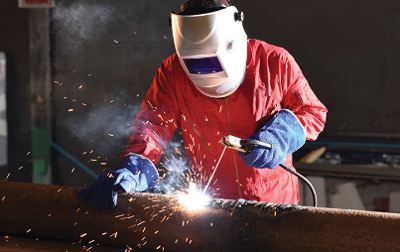
There’s just a certain beauty in being able to create things with your tools and the hands that hold them. One of the most common materials that you’re bound to find in the modern age is metal. It comes in so many varieties that it’s almost impossible for you to reach a lack of materials. Welding is the process by which extreme heat is applied to two metal parts in order to create a strong bond between them.
It only makes sense to learn a craft that involves the manipulation of abundant materials. So, if you’re planning on doing your own welding projects, there are a few things that every welder worth his or her salt should know.
Safety Precautions
Remember that you’re dealing with high temperatures and heat in welding. Never forget that welding bonds are created by melting two components and allowing them to solidify as a single piece. You should always have the proper safety equipment before you even begin — the most important things that you should have include safety glasses, welding gloves, an auto-darkening helmet (to protect your eyes from the flash), and a fire-resistant jacket.
You also need ventilation in order to avoid inhaling harmful post-weld fumes. Finally, always, always make sure to keep away from flammable materials when you weld. Sparks are bound to fly and they can easily ignite flammable materials if you’re not careful.
Welding Processes
There are three main types of welding processes: Wire Welding, Stick Welding, and TIG Welding. Each of these processes has its specific uses, but for the sake of brevity and relevance (since this article is for beginners), we’re going to focus on the welding process that you’re most likely going to learn first — stick welding.
Stick welding, also referred to as Shielded Metal Arc Welding (SMAW) is a welding process that makes use of a stick electrode (hence the name) to heat the metals. SMAW is considerably slower than MIG welding but makes up for it by being more forgiving when one is welding rusty or even dirty metal. It’s because of this that makes SMAW ideal for beginners.
Materials
As previously mentioned, there are different types of welding processes, each with its own traits. This is necessary because, depending on the type of material you’re working with, some welding processes will be better for certain types of metal. Aluminum, steel, and stainless steel all have different traits and because of this, it’s always best to ask what materials are going to be best to learn on.
Input Voltage
Finally, you have to consider input voltages. This is much easier than the previous items on this list because there are only two types of input voltages and they are also readily available in most homes. As a rule of thumb, the thickness of the material you’re working with is going to determine the type of voltage you need. So, for thinner materials, 110 volts is going to be enough to get the job done. For thicker materials, you’re going to want to use 230 volts.


(0) comments
We welcome your comments
Log In
Post a comment as Guest
Keep it Clean. Please avoid obscene, vulgar, lewd, racist or sexually-oriented language.
PLEASE TURN OFF YOUR CAPS LOCK.
Don't Threaten. Threats of harming another person will not be tolerated.
Be Truthful. Don't knowingly lie about anyone or anything.
Be Nice. No racism, sexism or any sort of -ism that is degrading to another person.
Be Proactive. Use the 'Report' link on each comment to let us know of abusive posts.
Share with Us. We'd love to hear eyewitness accounts, the history behind an article.